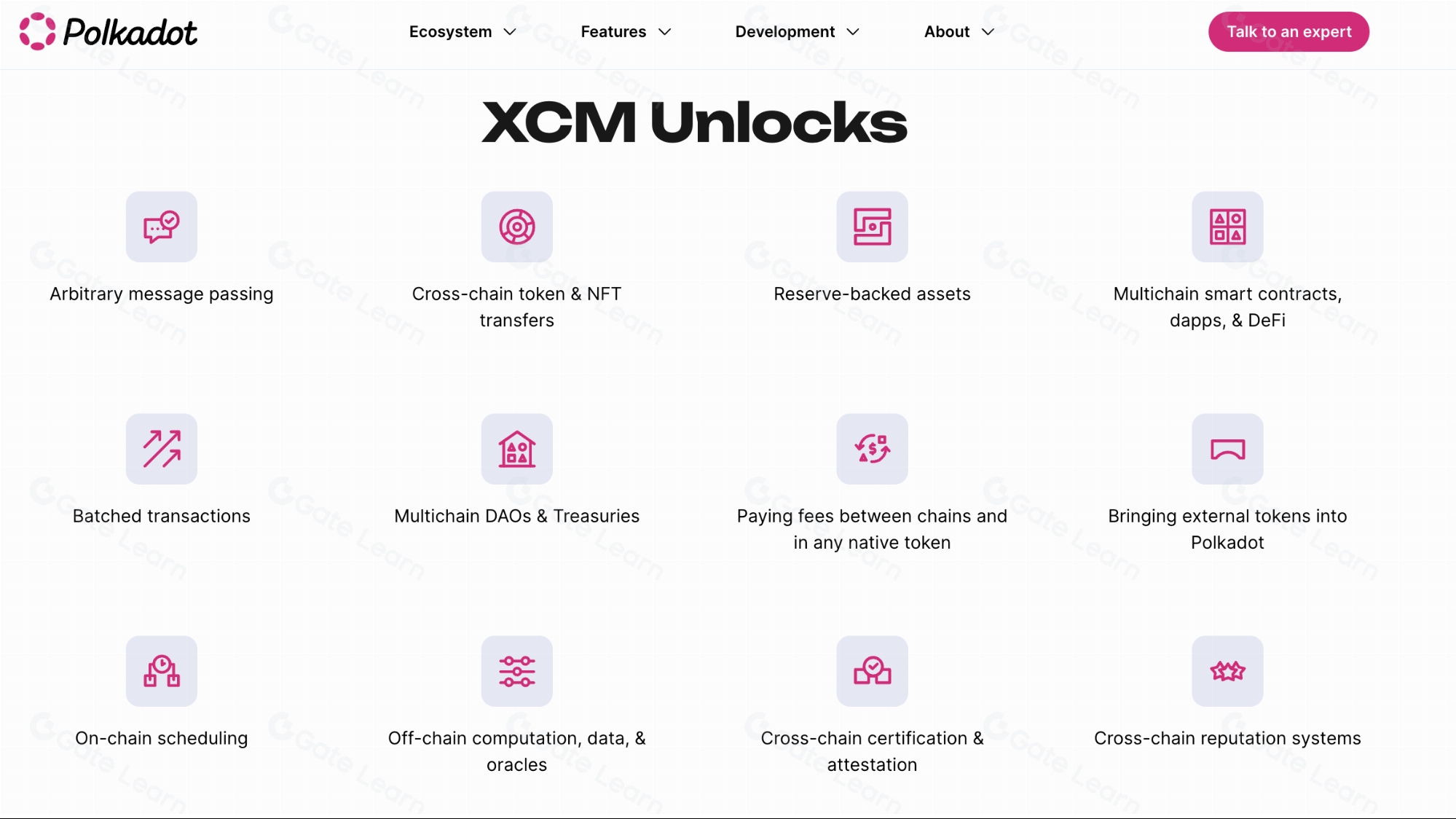Interopérabilité et Communication inter-chaînes
Le module 5 dévoile le concept d’interopérabilité, pierre angulaire de la conception de Polkadot, permettant à diverses blockchains de se connecter et de communiquer de manière transparente. Nous allons disséquer comment Polkadot non seulement réalise, mais optimise la communication inter-chaînes, assurant le transfert de données et d’actifs avec une fluidité et une sécurité sans précédent. Les participants en apprendront davantage sur la messagerie de consensus croisé (XCM) et sur la façon dont ce cadre facilite l’interaction entre les différentes plateformes de blockchain. Cette exploration soulignera l’importance de l’interopérabilité dans la réalisation du plein potentiel de la technologie blockchain.
Le Concept d'Interopérabilité dans la Blockchain
L'interopérabilité dans le contexte de la technologie blockchain fait référence à la capacité de différents protocoles blockchain de communiquer et d'interagir de manière transparente les uns avec les autres. Ce concept est crucial car les premières étapes du développement de la blockchain étaient caractérisées par de nombreux réseaux blockchain isolés, ou « silos », qui étaient incapables d'échanger des informations ou de la valeur entre eux. Ces silos ont créé un écosystème fragmenté qui a entravé l'avancement de la technologie car les données, les actifs et les services ne pouvaient pas être transférés entre les différents réseaux blockchain, limitant la portée des applications et services décentralisés possibles.
Le besoin d'interopérabilité découle du désir de créer un écosystème blockchain connecté et polyvalent similaire à l'internet moderne, où divers réseaux et protocoles distincts interagissent. En atteignant l'interopérabilité, les blockchains libèrent le potentiel d'une collaboration plus large, de processus rationalisés et d'applications multi-chaînes innovantes, contribuant à un espace blockchain plus inclusif et intégré. Cette intégration permet le transfert d'informations et d'actifs entre différentes blockchains, facilitant des transactions complexes, améliorant la liquidité et permettant un paysage de finance décentralisée (DeFi) multifacette.
L'interopérabilité va au-delà du simple transfert d'actifs ; elle implique la capacité des différents protocoles de blockchain à comprendre et à interpréter les transactions et les changements d'état des autres. Ce niveau d'interaction signifie que les actions effectuées sur une blockchain peuvent déclencher des réponses sur une autre, permettant un maillage d'activités interconnectées qui étendent considérablement les cas d'utilisation de la technologie blockchain. En éliminant les barrières entre les blockchains séparées, l'interopérabilité ouvre la voie à des applications innovantes inter-chaînes, à une meilleure expérience utilisateur et à une infrastructure blockchain unifiée et puissante.
Comment Polkadot facilite la communication inter-chaînes
Polkadot est à l’avant-garde de la résolution du défi de l’interopérabilité, en fournissant une plate-forme où diverses blockchains peuvent se connecter et interagir dans un environnement sans confiance. À la base, Polkadot est un réseau multi-chaînes, ce qui signifie qu’il prend en charge de nombreuses blockchains (parachains) connectées à une chaîne centrale connue sous le nom de Relay Chain. La chaîne de relais est au cœur de la fonction d’interopérabilité de Polkadot, coordonnant la sécurité, le consensus et l’interopérabilité inter-chaînes du réseau.
Une des principales innovations de Polkadot est son support de la communication inter-chaînes (CCC), permettant aux parachains d'envoyer des messages, y compris de la valeur et des données, les unes aux autres à travers la Chaîne Relais. Cette communication est facilitée par le protocole de passage de messages inter-chaînes (XCMP), qui permet à différents blockchains d'échanger des messages et d'effectuer mutuellement des transactions. En utilisant la Chaîne Relais comme médiateur, les parachains du réseau Polkadot peuvent interagir sans avoir besoin de se faire mutuellement confiance, car la sécurité de la Chaîne Relais garantit la validité des transactions.
Les implications de la communication inter-chaînes de Polkadot sont profondes, offrant le potentiel de diverses formes de collaboration entre différentes blockchains. Par exemple, un smart contract sur un parachain pourrait déclencher une transaction sur un autre, ou un utilisateur pourrait interagir de manière transparente avec des applications décentralisées (DApps) résidant sur différentes blockchains. Ce niveau d'interopérabilité améliore également la liquidité entre les chaînes, car les actifs et les données peuvent circuler librement dans l'écosystème.
L'architecture de Polkadot est conçue pour gérer divers types d'interactions inter-chaînes, y compris le transfert d'actifs, le partage de données et le passage de messages généraux. Cette flexibilité est cruciale pour favoriser un écosystème où des blockchains diverses peuvent coexister et se compléter mutuellement, conduisant à un internet de blockchains interopérables. En résolvant le défi de l'interopérabilité, Polkadot élargit considérablement les horizons de ce qui est possible dans l'espace blockchain, ouvrant la voie à des applications innovantes qui exploitent les forces combinées de plusieurs chaînes.
Comprendre la messagerie de consensus croisé (XCM)

La messagerie inter-consensus (XCM) est un protocole spécifique à Polkadot conçu pour faciliter la communication entre différentes blockchains qui peuvent fonctionner selon des règles de consensus différentes. XCM décrit un cadre permettant d'envoyer des messages entre différentes chaînes et de les interpréter de manière compatible avec les règles de consensus de la blockchain destinataire. Ce protocole est fondamental pour parvenir à une véritable interopérabilité dans l'écosystème Polkadot, permettant non seulement l'échange de messages, mais aussi la capacité d'interpréter et d'agir de manière cohérente sur ces messages.
XCM fonctionne à un niveau qui abstrait les mécanismes de consensus spécifiques des chaînes impliquées, se concentrant plutôt sur le contenu du message et l'effet voulu. Cette approche permet à XCM de prendre en charge une grande variété de mécanismes de consensus et d'architectures blockchain, en faisant une solution polyvalente et adaptable pour la communication inter-chaînes. Le protocole définit un ensemble de formats de message et de procédures pour l'envoi, la réception et l'exécution de ces messages, garantissant que les actions déclenchées sur une chaîne peuvent être correctement et sécuritairement reflétées sur une autre.
XCM a la capacité de gérer le transfert d’actifs entre différentes chaînes. Ce processus ne se limite pas à l’envoi d’une transaction. Il nécessite un moyen de verrouiller les actifs sur une chaîne, de communiquer la transaction à la chaîne destinataire, puis de déverrouiller des actifs équivalents de l’autre côté. XCM gère ce processus de manière sécurisée et sans confiance, en veillant à ce que les transferts d’actifs soient exécutés fidèlement et efficacement.
Au-delà des transferts d'actifs, le XCM est également conçu pour faciliter des interactions plus complexes, telles que des appels de contrats inter-chaînes, la récupération de données, voire la participation à des mécanismes de gouvernance étrangers. Ce niveau d'interaction est sans précédent dans l'espace blockchain et ouvre la porte à des applications multi-chaînes vraiment intégrées. Par exemple, une DApp sur une parachain pourrait récupérer des données d'une autre chaîne, exécuter un smart contrat sur une troisième chaîne et renvoyer les résultats à l'utilisateur, le tout dans un processus transparent et sans confiance.
La sécurité des transactions XCM est garantie par la sécurité globale de la chaîne de relais Polkadot. Comme tous les messages inter-chaînes passent par la chaîne de relais, ils bénéficient de ses mécanismes de consensus et de son réseau de validateurs, garantissant que les transactions inter-chaînes sont aussi sécurisées que les transactions intra-chaînes. Ce modèle de sécurité unifié est crucial pour maintenir la confiance dans l'écosystème, car il garantit que les interactions inter-chaînes ne peuvent pas être manipulées ou falsifiées.
Points saillants
- L'interopérabilité dans la blockchain est une avancée transformative, permettant à des protocoles blockchain distincts de communiquer et d'interagir, brisant les silos et favorisant un écosystème numérique plus intégré et collaboratif.
- Polkadot pionniers l'interopérabilité avec sa structure de réseau multi-chaînes, où la Relay Chain facilite une communication sécurisée et sans confiance entre chaînes, permettant à des blockchains diverses de transférer de la valeur, des données et d'effectuer des transactions entre elles.
- Le passage de messages inter-chaînes (XCMP) dans Polkadot permet à différents blockchains d'échanger des messages, améliorant la fonctionnalité et les applications potentielles des blockchains interconnectées et étendant l'expérience utilisateur à travers les chaînes.
- Le protocole de messagerie Cross-Consensus (XCM) dans Polkadot abstrait les mécanismes de consensus des chaînes individuelles, en se concentrant sur le contenu et l'effet des messages, garantissant une communication cohérente à travers diverses architectures blockchain.
- XCM facilite les transferts d'actifs sécurisés entre les chaînes, gérant le processus de verrouillage, de communication et de déverrouillage des actifs, garantissant des transactions inter-chaînes sans confiance et efficaces.
- Au-delà des simples transferts d'actifs, XCM prend en charge des interactions complexes entre chaînes, y compris des appels de contrats, la récupération de données et la participation à la gouvernance, permettant un nouveau niveau d'applications multi-chaînes intégrées.
- La sécurité des interactions inter-chaînes via XCM est garantie par la Relay Chain de Polkadot, assurant un modèle de sécurité unifié qui maintient la confiance et l'intégrité dans le processus de communication inter-chaînes.





